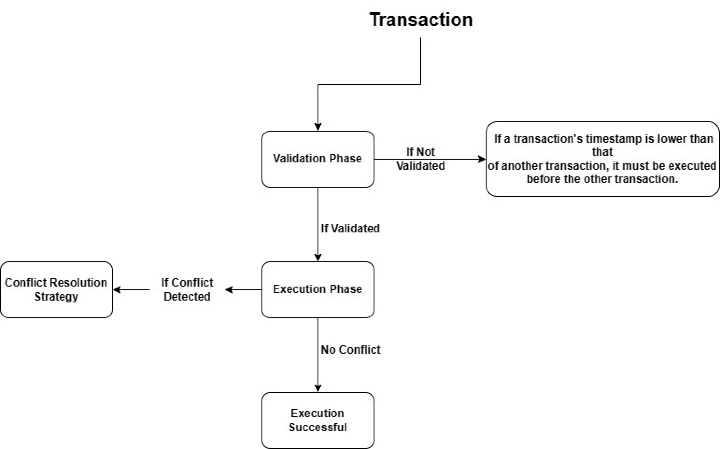
 Data Structure
Data Structure Networking
Networking RDBMS
RDBMS Operating System
Operating System Java
Java MS Excel
MS Excel iOS
iOS HTML
HTML CSS
CSS Android
Android Python
Python C Programming
C Programming C++
C++ C#
C# MongoDB
MongoDB MySQL
MySQL Javascript
Javascript PHP
PHP
- Selected Reading
- UPSC IAS Exams Notes
- Developer's Best Practices
- Questions and Answers
- Effective Resume Writing
- HR Interview Questions
- Computer Glossary
- Who is Who
Concurrency Control Based on Timestamp Ordering
A key idea in database management systems, concurrency control guarantees transaction isolation and consistency. A concurrency management mechanism called timestamp ordering gives each transaction a distinct timestamp and arranges the transactions according to those timestamps. The timestamp ordering mechanism, its goals, and its operation to guarantee transaction consistency will all be covered in this article.
Objectives of Timestamp Ordering
The main goal of timestamp ordering is to guarantee serializability, which means that the order in which transactions are completed must create the same outcomes as if they were executed serially. The following are the main goals of timestamp ordering ?
Transaction Ordering ? In order for the transaction outcomes and timestamps to match, the transactions must be carried out in the right order.
Conflict Resolution ? If two transactions are in conflict, the timestamp ordering mechanism must choose between terminating one of the transactions or postponing it until the other transaction is finished
Deadlock Prevention ? To avoid deadlocks, which occur while several transactions are awaiting one another's completion, the timestamp ordering mechanism must be used.
How Timestamp Ordering Works?
The timestamp ordering algorithm works by assigning a unique timestamp to each transaction when it arrives in the system. The timestamp reflects the transaction's start time, and it is used to order the transactions for execution. The algorithm consists of two phases: the validation phase and the execution phase.

Validation Phase ? The timestamp ordering method verifies each transaction's timestamp during the validation stage to make sure the transactions are performed in the proper sequence. When one transaction's timestamp is lower than another's, the earlier transaction must be carried out.
Execution Phase ? In the execution phase, the timestamp ordering algorithm executes the transactions in the order determined by the validation phase. If there is a conflict between transactions, the algorithm uses a conflict resolution strategy to resolve the conflict. One strategy is to abort the transaction with the lower timestamp, while another strategy is to delay the transaction with the lower timestamp until the other transaction completes.
Benefits of Timestamp Ordering
The benefits of timestamp ordering are as follows ?
Transaction Consistency ? Transaction consistency is ensured by the timestamp ordering method, which implies that regardless of how the transactions are conducted, the outcomes are the same as if they were carried out serially.
High Concurrency ? High concurrency is made possible via the timestamp ordering mechanism, which permits several transactions to run concurrently.
Deadlock Prevention ? While two or more transactions are awaiting one another's completion, a deadlock is avoided thanks to the timestamp ordering method.
Conclusion
Timestamp ordering is a concurrency management mechanism that gives each transaction a distinct timestamp and arranges the transactions according to those timestamps. The technique guarantees serializability settles disputes between transactions and averts deadlocks. A common concurrency control mechanism in database management systems is timestamp order, which offers high concurrency while guaranteeing transaction consistency.

